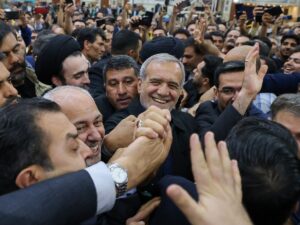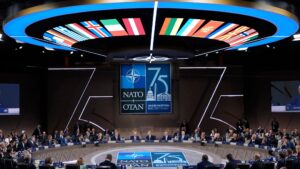
The National Interest Foundation Newsletter
Issue 244, July 12, 2024
Welcome to our NIF Newsletter. In this latest edition, we examine the surprising election results in France which saw a left-wing coalition win the most seats in parliament, analyze reformist lawmaker Masoud Pezeshkian’s victory in the Iranian presidential runoff election and its potential foreign policy implications, and explore the major takeaways from the North Atlantic Treaty Organization (NATO) summit in Washington D.C. this week.
Editor: Bassam Tarbush
Surprising Election Results in France as a Left-Wing Coalition Wins the Most Seats in Parliament

As the world watched closely, the election results from Sunday night saw the far-right suffer a shocking and significant blow. (Photo from Getty Images)
Surprising Election Results in France as a Left-Wing Coalition Wins the Most Seats in Parliament
Written By Camille Carter
While the U.S. election trails on until November, the much-anticipated decisive final round of the French election took place this past weekend, and the results shocked and surprised many. Under the watchful eye of observers around the world, the election results not only reflected the current sentiments of the French populace, but also signaled potential shifts in the broader European political climate. The far-right in France had made serious gains during the first round of elections which took place in late June, and was therefore anticipated to win the most seats in parliament in Sunday’s final run-off round. Instead, a loose coalition of leftist parties won the most seats, although no single party or alliance of parties was able to secure the at least 289 of the French National Assembly’s 577 seats needed to attain an outright parliamentary majority. Since no bloc was able to do so, France now has a hung parliament, and a coalition government will need to be formed between alliances or political parties in order to break the deadlock.
In France, the parliament is made up of two parts. The first is the National Assembly (Assemblée Nationale) which is the lower house, and members of that legislative body serve five-year terms. The second part is the Senate (Sénat) which is the upper house, and senators are elected for six-year terms through an indirect electoral system. The responsibilities of the parliament are very similar to what the U.S. Congress is in charge of overseeing. They debate and pass laws, approve the national budget, amend laws, and provide oversight for other government functions. Last month in June, French President Emmanuel Macron made what was regarded at that time as a historic and potentially risky move in dissolving the parliament and moving to a snap election: one which takes place earlier than the normally scheduled election. Typically, this occurs so that the political body can decide on a divisive issue, or to take advantage of a potential electoral opportunity for that entity to gain an upper hand.
However, a president cannot just call a snap election without following a few guidelines. First, before they dissolve the National Assembly, the president must consult with the prime minister and the leaders of both houses of parliament, and all must agree with it. Additionally, the election following the announcement must be held within 20-40 days of it being called for. Before this latest occurrence, the most recent call for a snap election in France was back in 1997 during President Jacques Chirac’s reign, one year before the election was scheduled to take place. This decision was partially a plot to catch his opposing party off guard and also aided by the population’s supposed dislike of the prime minister at the time, Alain Juppé. However, this backfired completely on Chirac and resulted in the first time in French history that a French President lost an election that was called on his own accord since the establishment of the snap election rules in 1958.
Leading up to the election, news outlets from all over the world were reporting it as one that would divide the country. Earlier in June, President Emmanuel Macron’s party, Renaissance, was beaten out in the polls for France’s seat in the European Parliament. The National Rally party, headed by Marine Le Pen, won around 32% of the votes, beating Macron’s party by nearly 17 points. These results worried many in France and abroad, as it appeared that it was following in the footsteps of other European countries and witnessing a surge in more conservative and right-winged governments. With the latest election results however, it appears that the French population was not willing to turn the country over to right-wing ideals so fast and as NPR reported, “There’s a saying: in the first round you vote with your heart, in the second, with your head. That means second-round choices are often “tactical” – not in favor of a particular candidate per se, but to make sure another one doesn’t win.” Thus, this past Sunday, July 7th, a record-breaking number of French people came out to the polls to ensure that their voice was heard and to advocate for their desires from the government.
All of this resulted in a defeat not only to the far-right National Rally Party, but also to President Macron’s party as well. After the numbers were finally counted and verified, the New Popular Front walked away with the most seats, winning 182. Following Macron’s attempt at joining two factions of the government, the Ensemble Alliance won 163 seats. Finally, the initial projected winners, the National Rally Party, only earned 143 seats. In total, France’s parliament has 577 seats, meaning that to ensure a party has a majority, it needs 289 of those seats. No party or alliance was able to secure that feat, but many are taking the defeat of the far-right party as a hopeful sign for the future.
As partisan politics continue to polarize much of the world, the outcome of the French election serves as a reminder that the will of the people can still prevail. The surprising results underscore the importance of active civic participation, and the power of collective action in shaping the future of a nation. As Americans prepare for the upcoming November election, many are hoping that this will serve as an inspiration to stay informed, engaged, and ready to make their voices heard.
Reformist Pezeshkian’s Victory in the Iranian Presidential Election and Its Potential Foreign Policy Implications

Pezeshkian is Iran’s first reformist president elected in nearly two decades. (Photo from AFP)
Reformist Pezeshkian’s Victory in the Iranian Presidential Election and Its Potential Foreign Policy Implications
Written By Sheyanne Barr
Iran’s reformist candidate has beaten the odds to become the ninth president of the theocratic nation, and many are pensive about what this could mean. On the surface, the 69-year-old heart surgeon appears to possess a desire to move the country forward in the right direction, but by and large, most experts contend that there is little hope for any form of widespread change emanating from Tehran. The truth of it is that Iran will remain an example of extreme theocratic rule for the foreseeable future, but it is unlikely to grow even more authoritarian in nature. Pezeshkian campaigned on a platform of economic growth, which may indicate new grounds to negotiate as he seeks to reduce the sanctions placed on Iran as a result of the continued development of nuclear arms and its support of militant groups.
Despite the hope that Pezeshkian’s election may bring, expectations must be adjusted for what changes are likely to happen in the nation. President Pezeshkian must still defer to Iran’s Supreme Leader Ali Khamenei who has control and the final say over most aspects of the country’s governance. Khamenei would likely pose heavy opposition to any more liberal-leaning change Pezeshkian or the average citizen of Iran may wish to enact. Historically, Khamenei has favored extremely conservative policies and hardline presidents who are willing to push them. However, Khamenei has had to contend with growing public discourse around his governance, and the oppressive nature of the regime. Considering Pezeshkian’s predecessor’s hardline views on foreign relations, the economy, and the use of the Iranian morality police, it should come as no surprise that many in the country have signaled a desire for a change of course with their vote.
Pezeshkian himself has signaled a desire for change. He has been outspoken about “ending Iran’s isolation,” bringing “unity and cohesion,” and has made remarks about the need for “constructive relations with the West.” Pezeshkian has also signaled a desire to return to the original Iran nuclear deal. Should this be the case, there will be a much higher chance that the United States and Iran can engage in constructive dialogue. These stances, combined with his criticism of the morality police, set him apart from his electoral opponent Saeed Jalili. Pulling in just over 46% of the votes cast, the ultraconservative Jalili failed to garner the voter turnout that was anticipated. Jalili, who previously held the position of Iran’s top nuclear negotiator, was running on a platform that seemed to pay an ode to how the Taliban have chosen to govern Afghanistan. Bearing this in mind, it is easy to see why he failed to capture the majority vote from a citizenry who, in 2022, took to the streets in massive numbers to protest the death of Mahsa Amini – who died in police custody after being detained over allegedly improperly wearing her head covering. The protests that resulted from this came after years of deteriorating women’s civil rights and a restless middle class that continues to express distaste for the regime. One of the most prevalent pieces of evidence of this unrest can be seen in the 4.2% of ballots that were left blank, voided, or cast for other candidates during the recent election.
Iranian President-Elect Pezeshkian is the first reformist to hold office since the political faction left power back in 2005. In the nearly 20 years since, Iran has seen many conservative hardliners in office who have left lasting impacts on the country’s political landscape. The mix of successes and failures of ultraconservative governance has led to doubling down on nuclear arms development, sponsoring militant groups, and stiffening security forces to clamp down on civil unrest. There has also been considerable economic expansion, middle-class development, and an increasingly large role in global affairs. Considering how the major reformist movement during 2009’s presidential election ended in months of repression, mass round-ups, and eventually executions, the election of a reformist candidate may have come as a significant shock for many in the country. Pezeshkian may also present a major opportunity for the Iranian government to regain some of its legitimacy, which it has undoubtedly lost in the eyes of those who have been negatively impacted by 20 years of hard-right leadership.
If we were to judge Pezeshkian by his words alone, there would be cause for a great deal of optimism for Iran’s near future, especially when one considers that Iran will likely be seeing a change in the most powerful seat in the country (the Supreme Leader) in the coming years. However, skeptics argue that Pezeshkian may very well be a reformist in words alone and that he has historically held an unwavering loyalty to Iran’s Khamenei. Despite having served in Iran’s last reformist leader’s cabinet as Minister of Health, he has not been shy about his role in the suppression of women’s rights and establishment of Iran’s theocratic regime, while also supporting the cavalcade of hard-right policies that have been enacted during his time in government. For meaningful change to occur and progress to be made by Iran’s new president, it will first have to pass muster from Iran’s Supreme Leader, the Majles, and the Guardian Council. However, if Pezeshkian “walks like he talks,” there may yet be hope for some positive change in Iran.
Major Takeaways from the NATO Summit in Washington D.C.

NATO leaders assembled in Washington D.C. to discuss daunting challenges around the globe. (Photo from AP)
Major Takeaways from the NATO Summit in Washington D.C.
Written By Cameron Reynolds
This week’s North Atlantic Treaty Organization (NATO) summit memorialized the 75th anniversary of the intergovernmental military alliance. U.S. President Biden welcomed world leaders to Melon Auditorium in Washington D.C. beginning on Tuesday evening – the same venue where the treaty was signed back in April of 1949. The summit was aimed at instilling confidence amongst the allies during a time of both domestic uncertainty in the United States and significant global challenges. Biden has been under intense scrutiny following his poor recent debate performance against former U.S. President Trump. The incumbent president has spent the last few weeks fending off concerns regarding his age, cognitive capability, and a growing number of calls for a replacement Democratic party nominee. Many world leaders are uneasy regarding the possibility of another Trump presidency and what it may mean for the alliance moving forward.
Various observers viewed the summit as an opportunity for President Biden to try and prove his mental fitness for a potential second term in office. Furthermore, the global stage gave him the platform to promote his internationalist approach to world issues. NATO allies entered the week prepared to discuss a daunting agenda of topics. The summit entailed a plethora of issues including support for Ukraine, defense spending, and China. The alliance also faced disunity among its own members. Hungary and Turkey, both friendly with Russia, have delayed Finland and Sweden’s recent bids to join the organization. Additionally, Prime Minister Viktor Orban of Hungary has strong ties to Russia and has frequently blocked aid from the European Union to Ukraine, heightening tensions within the military alliance. Canada has also faced backlash for not meeting the defense spending requirement, despite being one of the richer members, and U.S. Congress has openly expressed its indignation to Canada on the matter.
There are several key takeaways from this week’s summit. NATO leaders collectively confirmed Ukraine’s future membership in NATO. Yet, no specific timeline has been set for Ukraine’s “irreversible” membership. Several NATO members have signed long-term security agreements with Ukraine since the war started. The alliance committed to long-term support for Ukraine through the summit declaration that was issued on Wednesday. The U.S. confirmed that F-16 fighter jets will be sent to Ukraine, along with an additional supply of air defense equipment. The continued supply of military technology to Ukraine comes at a time when some U.S. Senate Republicans have criticized Biden for what they deem to be a “delayed response to Ukrainian needs.” Countering Russian advancements and threats was a hot topic of debate as well. Biden has called on all alliance members to increase their industrial production to match Russia’s significant military manufacturing. Plans for a cyber defense center were also announced, in the hopes of deterring increasing hacking threats against alliance members. The cyber defense mandate entails the sharing of threat intelligence on private infrastructure amongst members. For their part, Russian hackers have even admitted to targeting NATO websites and entities in the past. President Biden’s ability to function effectively during an unscripted event such as this was a major focus of the summit too. Biden had a couple of gaffs during his Wednesday night speech at the White House, but seemed attentive and present in the midst of other world leaders’ remarks. Reporters asked the president questions about his viability as the Democratic nominee and what a second Trump term would do to the alliance. Biden underscored the importance of the alliance in combatting global threats, particularly in an increasingly interconnected world.
The summit this week also took place amidst looming uncertainty regarding the future of the alliance. Former President Trump has been skeptical of U.S. membership, and has not stated clearly what the United States’ role in NATO would be should he be elected for a second term this November. Trump has referred to the alliance as “obsolete,” and thus various NATO members are weary of their ability to potentially counter Russian aggression without the support of the U.S. if Trump is elected. The former president has consistently conveyed his discontent with defense spending in NATO, and he has stated that he would refuse to defend nations that do not contribute at least 2 percent of their gross domestic product to their own defense. The rise of far-right populism in Europe also poses a challenge to the future of the organization, especially in countries such as Hungary and France, who have been substantial parts of the foundation for trying to maintain security and stability in the aftermath of World War II. British Prime Minister Keir Starmer made his first appearance at the summit following his Labour Party’s recent general election victory in the United Kingdom. Starmer has expressed his support for NATO and Ukraine, but the rise of far-right parties across the European continent could possibly diminish the strength of the alliance. The potential return of Donald Trump to the Oval Office, coupled with the increased presence of far-right politics in Europe, could halt future support for Ukraine.
Despite some internal concerns, the organization can be viewed as stronger than at any time before in its history. NATO has added two members since Russia’s invasion of Ukraine back in 2022, and the inclusion of both Finland and Sweden’s highly-suited militaries solidifies NATO’s 32-member roster. According to NATO Secretary-General Jens Stoltenberg, 23 of the 32 member countries will achieve or exceed the 2 percent defense spending threshold this calendar year – a notable increase from just 6 members meeting this requirement back in 2021. Overall, the European allies of NATO have also increased defense spending in an effort to counter impending threats from the Putin regime in Russia.
